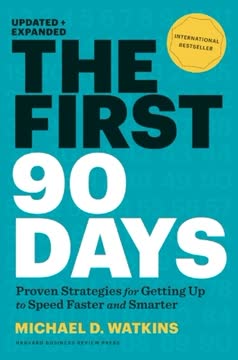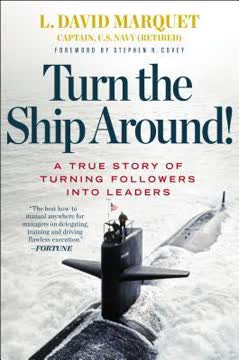Key Takeaways
1. The Middle is where transformations succeed or fail
It's easy to get excited at the beginning and define long-term goals at the end. It's the "Middle" that's the problem!
The long, challenging Middle. Transformations often stall after the initial excitement wears off. The Middle is where real change happens, but it's also where people lose focus and motivation. Leaders must maintain momentum through this extended period by:
- Clearly defining what needs to happen in the Middle
- Setting concrete milestones and control points
- Consistently reinforcing the importance of the change
- Addressing obstacles and setbacks quickly
Overcoming inertia. The pull to return to old ways of working is strong. Combat this by:
- Regularly communicating progress and small wins
- Celebrating milestones to maintain enthusiasm
- Addressing doubts and concerns openly
- Demonstrating unwavering commitment to the change
2. Create concrete outcomes and control points to drive action
A good strategy describes what you will do during the Middle.
From vague to specific. Avoid high-level, ambiguous goals. Instead, define concrete outcomes that clearly describe what success looks like. This makes the path forward obvious and actionable. For example:
Vague: "Improve customer satisfaction"
Concrete: "Reduce customer support response time to under 2 hours by Q3"
Measure what matters. Identify key control points – critical metrics that indicate progress toward your goals. Focus on outcomes, not just activities. Examples:
- Number of successful customer pilots (vs. number of sales calls made)
- Percentage of employees trained on new process (vs. training hours delivered)
- Revenue from new product line (vs. number of products launched)
Resource allocation. Your strategy is where you put your resources. Ensure concrete outcomes are adequately funded and staffed to drive real progress.
3. Build the right team and develop their capacity
There is no effective antidote for the wrong team.
Assess and align. Evaluate your current team against the needs of your transformation. Be honest about gaps in skills, mindset, or motivation. Key questions:
- Are all team members facing forward and aligned on the goal?
- Can each person pull their weight and contribute effectively?
- Is everyone motivated to go where you need to go?
Make tough decisions. Don't hesitate to make necessary changes. This may involve:
- Reassigning team members to roles that better fit their strengths
- Providing additional training and development
- Bringing in new talent with needed skills or experience
- Removing individuals who aren't aligned or capable
Develop capacity. Continuously build your team's capabilities:
- Delegate stretching assignments
- Provide regular feedback and coaching
- Encourage calculated risk-taking and learning from failures
- Invest in training and mentorship programs
4. Use Valor to face obstacles and maintain momentum
If you are going through hell—keep going!
Expect resistance. Transformation is hard. Prepare for:
- Skepticism and doubt from team members
- Unexpected obstacles and setbacks
- Pressure to abandon the change and return to old ways
Maintain resolve. Leaders must demonstrate unwavering commitment:
- Address concerns openly and honestly
- Make tough decisions, even when unpopular
- Stay focused on the long-term vision, despite short-term pressures
Ruthless prioritization. You can't do everything. Choose 1-3 ruthless priorities that are non-negotiable. Communicate these clearly and consistently.
Embrace productive conflict. Don't avoid necessary disagreements. Create clarity by working through conflicting viewpoints and trade-offs openly.
5. Foster organization-wide conversation about the change
You have communicated successfully when the people in your organization are talking about it amongst themselves.
Beyond top-down communication. Transformation requires active engagement from everyone. Create opportunities for dialogue at all levels:
- Host regular town halls and Q&A sessions
- Encourage team discussions about the change
- Use internal social platforms to facilitate conversation
Make it personal. Help individuals understand how the change impacts them and why it matters. Address the "What's in it for me?" question directly.
Amplify bright spots. Identify and celebrate early adopters and success stories. Use these examples to inspire others and demonstrate progress.
Create safe spaces. Encourage open, honest dialogue about challenges and concerns. Address issues transparently to build trust and maintain momentum.
6. Decorate the change to make it visible and tangible
Decorating the change went a long way towards calming everyone who was weary from too many re-orgs in the past.
Make it real. Use physical and virtual artifacts to reinforce the change:
- Update office spaces to reflect new ways of working
- Create visual representations of goals and progress
- Design branded materials (e.g., t-shirts, posters) to build identity
Rituals and ceremonies. Establish new routines that embody the change:
- Launch events to kick off key initiatives
- Regular check-ins or stand-ups focused on transformation goals
- Celebrations to mark milestones and recognize contributions
Leverage existing culture. Find ways to connect the change to positive aspects of your current culture. This helps make the transition feel more natural and less jarring.
7. Communicate consistently and listen purposefully
Only when you are mind-numbingly bored with talking about your strategy will your organization begin to feel confident about acting on it.
Repetition is key. People need to hear messages multiple times before internalizing them. Aim for the "Rule of 21":
- Communicate your key messages at least 21 times
- Use various channels and formats to reach different audiences
- Maintain consistency in core messages while adapting to specific contexts
Show alignment. Ensure your entire leadership team is visibly on board:
- Have leaders regularly reinforce key messages
- Address any perceived disagreements or mixed signals quickly
Listen actively. Create channels for ongoing feedback:
- Hold regular listening sessions with employees at all levels
- Use surveys and anonymous feedback tools
- Act on insights gained to demonstrate responsiveness
Stay connected to reality. Don't rely solely on filtered information from direct reports. Make time to talk directly with people doing the work to understand real challenges and opportunities.
Last updated:
FAQ
What's Move: How Decisive Leaders Execute Strategy Despite Obstacles, Setbacks, and Stalls about?
- Focus on Execution: The book emphasizes the importance of executing strategies effectively, particularly during the challenging "Middle" phase of transformation.
- MOVE Model: Patty Azzarello introduces the MOVE model, which stands for Middle, Organization, Valor, and Everyone, providing a structured approach to strategy execution.
- Real-World Application: Based on Azzarello's extensive experience, the book offers practical advice and actionable insights for leaders to drive their organizations forward.
Why should I read Move: How Decisive Leaders Execute Strategy Despite Obstacles, Setbacks, and Stalls?
- Practical Guidance: The book provides real-world solutions and frameworks that can be applied immediately by leaders facing challenges in executing strategies.
- Engagement of All Levels: It emphasizes the need for involvement from everyone in the organization, fostering a culture of accountability and ownership.
- Avoiding Common Pitfalls: Readers can learn to identify and avoid common traps that lead to stalled initiatives, such as lack of clarity and ineffective communication.
What are the key takeaways of Move: How Decisive Leaders Execute Strategy Despite Obstacles, Setbacks, and Stalls?
- Importance of the Middle: The "Middle" phase is where most strategies stall, and leaders must focus on maintaining momentum and clarity.
- Concrete Outcomes: Defining specific, actionable outcomes rather than vague goals helps teams understand expectations and measure progress.
- Engagement and Communication: Effective communication and engagement at all levels are crucial for successful execution, fostering alignment and motivation.
What is the MOVE model in Move: How Decisive Leaders Execute Strategy Despite Obstacles, Setbacks, and Stalls?
- Four Key Elements: The MOVE model consists of Middle, Organization, Valor, and Everyone, each addressing a critical aspect of executing strategy.
- Middle: Focuses on the execution phase where strategies often stall, requiring defined actions to maintain momentum.
- Organization: Emphasizes the need for the right team structure and personnel to support transformation, assessing team capabilities and needs.
How can I maintain momentum during the Middle phase according to Move?
- Define Mid-Term Checkpoints: Establish clear, measurable milestones to track progress and keep the team focused and accountable.
- Create a Timeline: Use a timeline to visualize the journey, marking key outcomes and deadlines to maintain urgency and clarity.
- Regular Communication: Consistently communicate progress and celebrate small wins to keep the team motivated and aligned.
What are some common pitfalls in executing strategy as outlined in Move?
- Busy Work: Organizations often neglect strategic initiatives due to day-to-day operations, highlighting the need to prioritize strategic work.
- Lack of Clarity: Unclear expectations and goals can lead to failure; leaders must ensure everyone understands their roles and desired outcomes.
- Resource Allocation Issues: Proper resource planning is crucial to avoid stalling new initiatives, aligning resources with strategic priorities.
How do I build the right team for transformation according to Move?
- Assess Current Team: Evaluate whether your existing team has the skills and motivation needed for the new strategy, being honest about contributions.
- Recruit Continuously: Always look for talent, even without open positions, to build relationships with potential hires for future needs.
- Focus on Strengths: Align team members with roles that match their strengths to enhance performance and engagement.
How does Move address the challenges of decision-making?
- Encourage Timely Decisions: Emphasizes the importance of making decisions promptly to avoid stagnation, acting when enough information is available.
- Balance Input and Authority: Leaders should gather input from teams while being decisive, ensuring decisions are informed yet timely.
- Create a Culture of Accountability: Establish clear expectations and consequences for decision-making, encouraging ownership and responsibility.
How can I build trust within my team according to Move?
- Share Power: Leaders should share power and respect with their teams, fostering loyalty and encouraging ownership of work.
- Open Communication: Engage in open conversations to understand team concerns and motivations, creating a supportive environment.
- Recognize Contributions: Acknowledge and celebrate achievements, boosting morale and reinforcing the importance of individual contributions.
What role does communication play in executing strategy according to Move?
- Clarity and Consistency: Clear and consistent communication ensures everyone understands the strategy and their roles, reducing confusion.
- Foster Conversation: Leaders should create an environment where ongoing conversation is the norm, maintaining engagement and allowing for feedback.
- Top-Down and Bottom-Up: Communication should flow in both directions, with leaders sharing their vision and listening to team feedback for alignment.
What are some effective strategies for engaging remote teams as suggested in Move?
- Regular Check-Ins: Implement regular check-ins to maintain communication and connection among remote team members, ensuring alignment.
- Use Technology: Leverage tools like video conferencing and instant messaging to facilitate collaboration and maintain team cohesion.
- Encourage Team Building: Organize virtual team-building activities to foster relationships and camaraderie, enhancing trust and collaboration.
What are the best quotes from Move and what do they mean?
- “If you want a mission that employees care about, it starts with you actually caring about something.”: Emphasizes the importance of genuine leadership and commitment to the mission.
- “You can't do your job without knowing the things you learn from these conversations.”: Highlights the value of listening to team members for effective decision-making and strategy execution.
- “If you want something to happen, make sure everyone keeps talking about it.”: Underscores the necessity of ongoing conversation in driving change and maintaining focus.
Review Summary
Readers highly praise Move for its practical, actionable advice on executing organizational change. Many found it invaluable for leaders navigating complex transformations. The book's MOVE model (Middle, Organization, Valor, Everyone) resonated with readers, offering concrete strategies for implementing change and engaging employees. Reviewers appreciated the author's concise, clear writing style and relatable examples. While some found parts obvious or struggled with certain sections, most considered it an essential read for managers and executives leading strategic initiatives or long-term projects.
Similar Books










Download PDF
Download EPUB
.epub digital book format is ideal for reading ebooks on phones, tablets, and e-readers.





